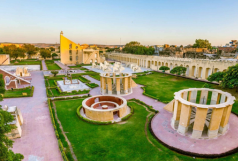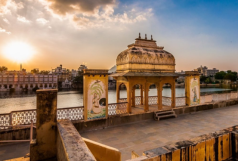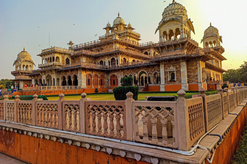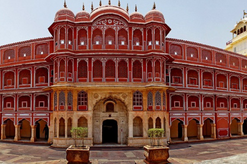Jodhpur, Popularly Known as the Blue City for its Blue Buildings
Jodhpur, often referred to as the 'Blue City,' is a mesmerizing destination located in the heart of Rajasthan. Famous for its striking blue-colored houses that line the old city, Jodhpur is a city of vibrant culture, majestic forts, and a rich historical legacy. Nestled at the edge of the Thar Desert, the city offers a perfect blend of ancient architecture, lively markets, and picturesque landscapes, making it a must-visit destination for travelers.
This blog explores the unique charm of Jodhpur, delving into its famous attractions and the reason behind its iconic blue hue. From the towering Mehrangarh Fort to the serene Jaswant Thada, Jodhpur promises an unforgettable journey through Rajasthan’s regal past and vibrant present.
Why is Jodhpur Called the Blue City?
The moniker 'Blue City' comes from the blue-colored houses scattered throughout the old city area, particularly near Mehrangarh Fort. The color blue was traditionally associated with the Brahmins, the priestly class, but over time, other residents also adopted the color. The blue hue is believed to keep homes cooler during the scorching summer heat and is a symbol of royalty and prestige in the city.
Mehrangarh Fort
The Mehrangarh Fort is the crown jewel of Jodhpur and one of the largest forts in India. Perched atop a hill, the fort offers stunning panoramic views of the city, where you can see the famous blue houses spreading below. Built in 1459 by Rao Jodha, the founder of Jodhpur, Mehrangarh Fort stands as a symbol of Rajput valor and architectural brilliance.
Inside the fort, visitors can explore several palaces, courtyards, galleries, and temples. The fort museum houses an impressive collection of artifacts, including royal palanquins, costumes, arms, and paintings that reflect the rich history of the Rathore dynasty. A walk along the fort’s ramparts offers breathtaking views of the city and the surrounding landscape.
Jaswant Thada
Just a short distance from Mehrangarh Fort lies Jaswant Thada, a beautiful marble cenotaph built in memory of Maharaja Jaswant Singh II. Often referred to as the 'Taj Mahal of Marwar,' Jaswant Thada is renowned for its intricate carvings, serene atmosphere, and stunning location amidst lush gardens. The white marble structure contrasts beautifully with the blue buildings of the city, making it a popular spot for visitors.
The cenotaph is surrounded by a peaceful garden and a small lake, offering a tranquil retreat after exploring the bustling city. Visitors can take a leisurely stroll around the complex and admire the intricate marble work and vibrant frescoes inside.
Umaid Bhawan Palace
The Umaid Bhawan Palace is one of the last great palaces built in India and serves as a symbol of the modern era of Jodhpur. Part of the palace is still the residence of the royal family, while another section has been converted into a luxury hotel and museum. The palace was completed in 1943 and is a magnificent blend of Indo-Saracenic and Art Deco styles.
The museum at Umaid Bhawan Palace offers a glimpse into the royal lifestyle, showcasing vintage cars, royal artifacts, and photographs of the Maharajas. The grandeur of the palace, along with its well-manicured gardens, makes it a must-visit for history enthusiasts and architecture lovers alike.
Clock Tower and Sardar Market
The Clock Tower, also known as 'Ghanta Ghar,' is a bustling landmark in the heart of Jodhpur's old city. Nearby is Sardar Market, a lively market where visitors can shop for handicrafts, textiles, spices, and traditional Rajasthani attire. The vibrant market offers a true taste of Jodhpur’s local culture, with bustling lanes filled with colorful goods, delicious street food, and the sounds of bargaining merchants.
From traditional Bandhani fabrics to intricate silver jewelry, Sardar Market is the perfect place to pick up souvenirs that represent the rich craftsmanship of Rajasthan.
Mandore Gardens
Mandore, the ancient capital of the Marwar region, is home to the beautiful Mandore Gardens. These gardens are dotted with cenotaphs (chhatris) of former Marwar rulers and are a peaceful escape from the city. The cenotaphs are intricately carved and stand as a testament to the architectural excellence of the Rajputs.
In addition to the cenotaphs, Mandore Gardens also feature a small museum, a temple, and various sculptures that narrate the glorious past of the region. The lush green surroundings make it an ideal spot for a relaxing afternoon or a family picnic.
Bishnoi Village Safari
A visit to Jodhpur is incomplete without experiencing the rural life and culture of the Bishnoi community. The Bishnoi Village Safari takes visitors to nearby villages where they can witness the traditional lifestyle of the Bishnois, known for their deep respect for nature and wildlife. The Bishnoi community is famous for its environmental conservation practices and the protection of animals like the blackbuck.
During the safari, visitors can observe pottery-making, weaving, and other local crafts. It’s a great opportunity to interact with the villagers and learn about their unique traditions and values.
Conclusion
Jodhpur, with its blue-hued buildings, majestic forts, and rich cultural heritage, is a destination that captivates every traveler. From the awe-inspiring Mehrangarh Fort to the serene Jaswant Thada and the bustling markets of the old city, Jodhpur offers a diverse experience of Rajasthan’s royal and cultural legacy.
Whether you're exploring its grand palaces, enjoying traditional Rajasthani cuisine, or shopping for local handicrafts, Jodhpur has something for everyone. Plan your Jodhpur sightseeing tour to discover why this city is truly one of the gems of Rajasthan.
























